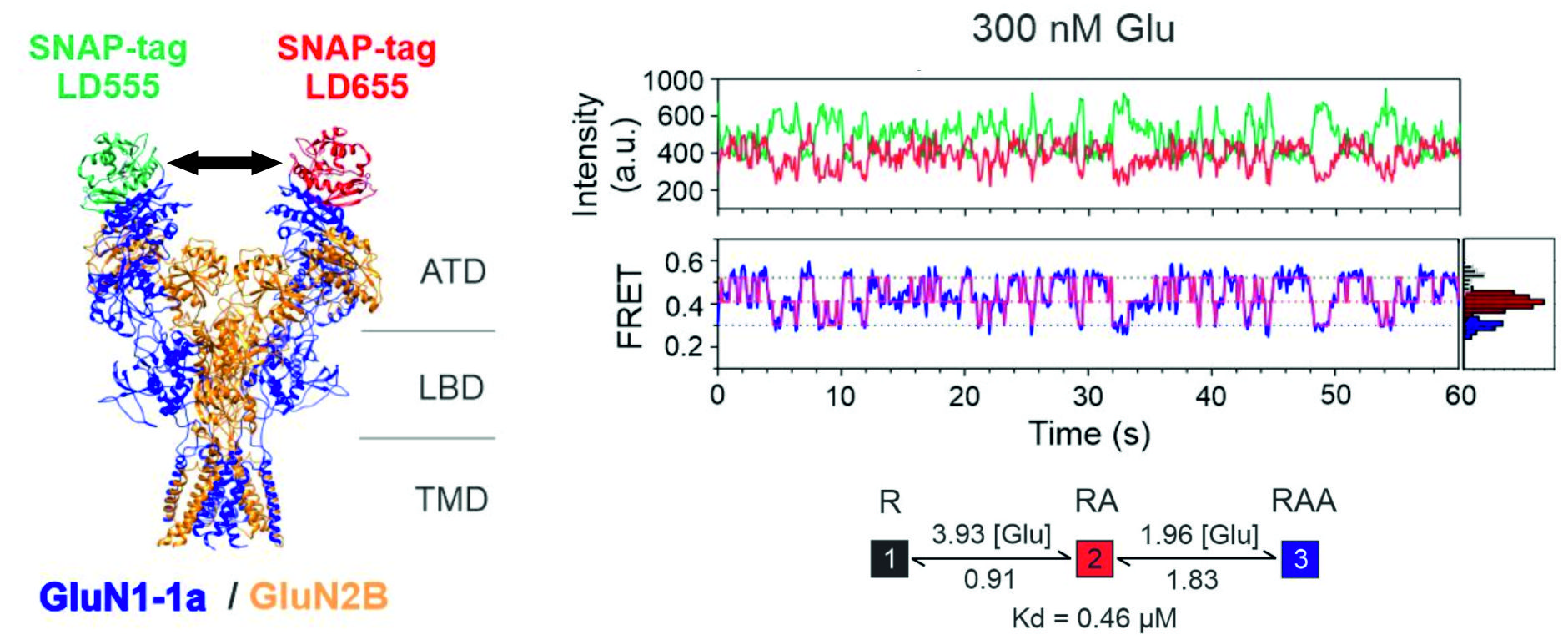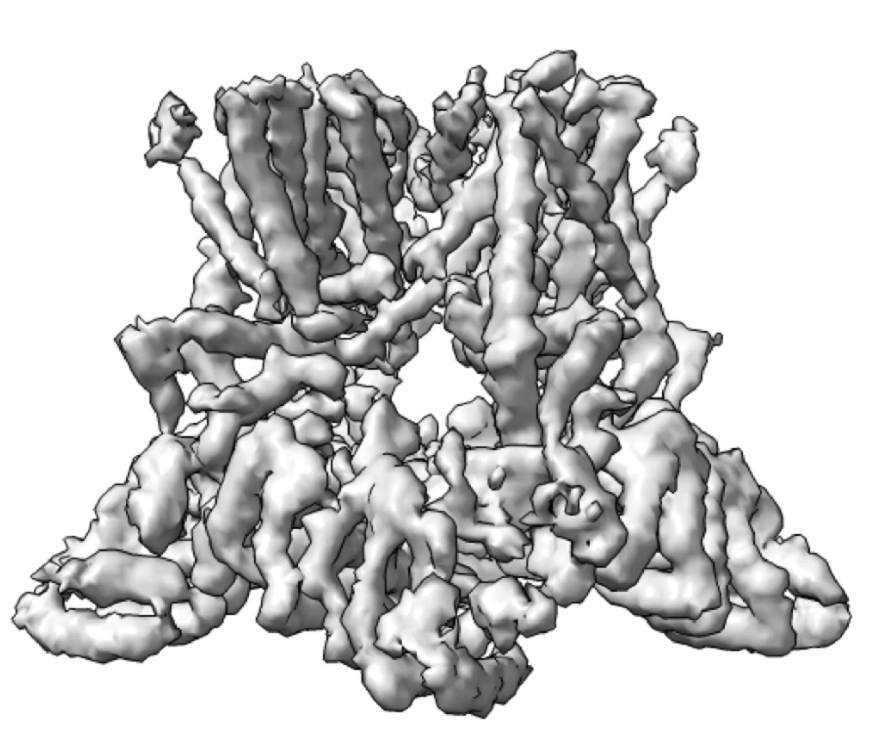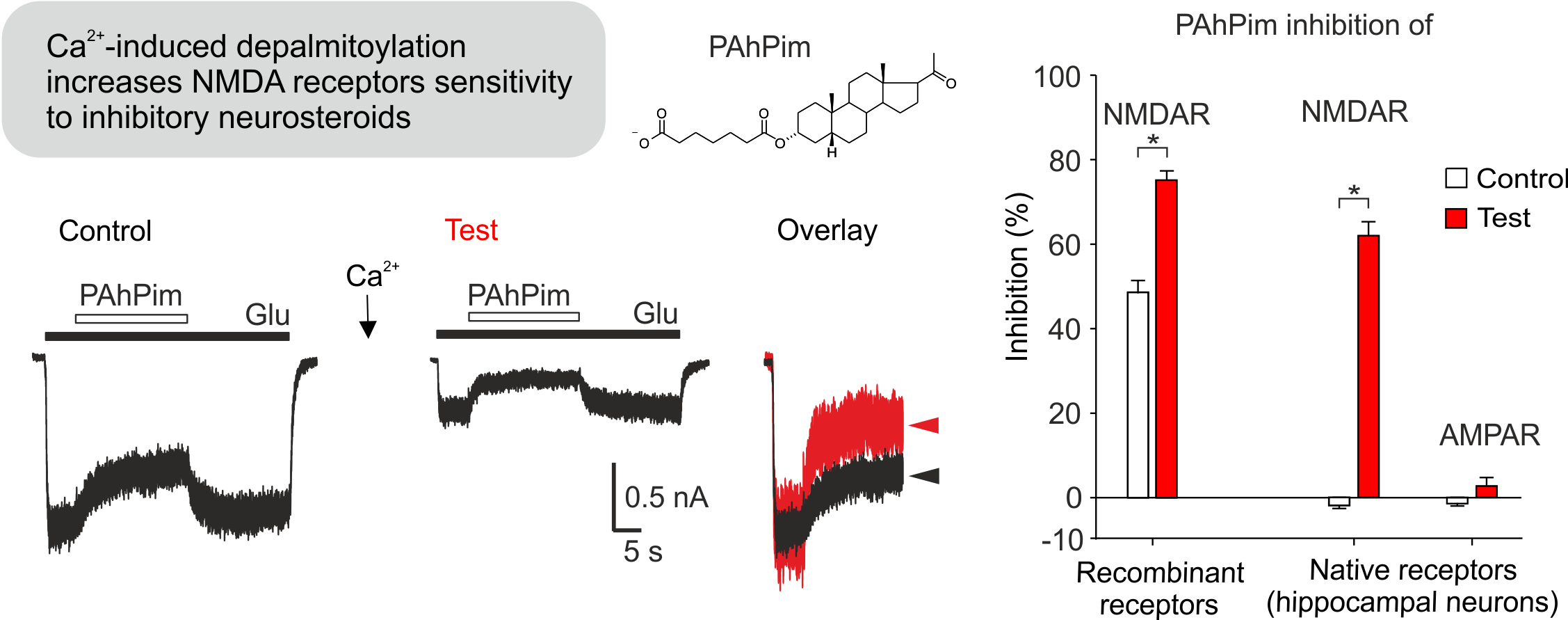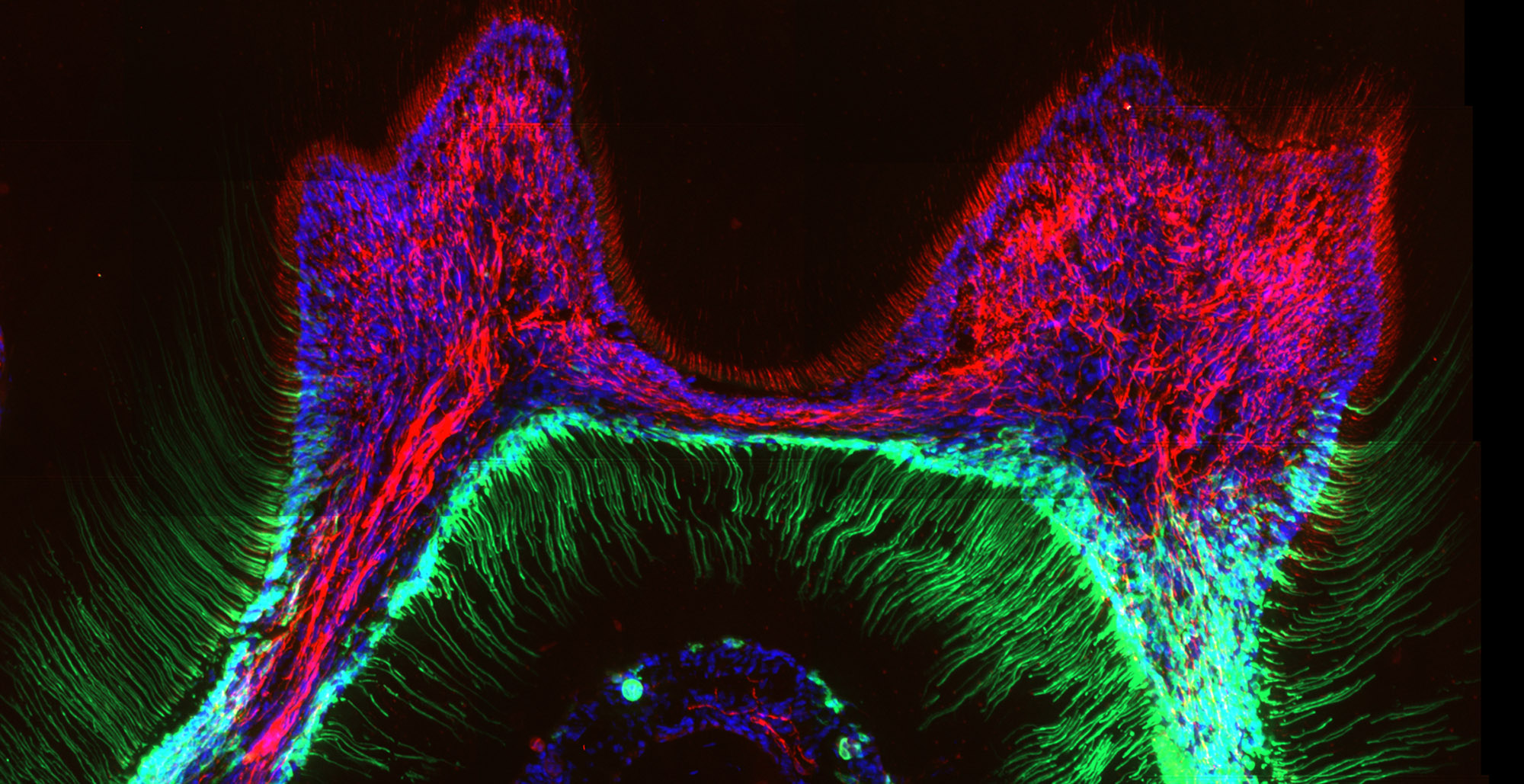Targeted modulation of NMDA receptors is a key for the effective treatment of neurological and neurodevelopmental diseases (14.10. 2021)
N-methyl-D-aspartate (NMDA) receptors are glutamate-gated ion channels critically involved in excitatory synaptic transmission that play a key role in learning and memory. Impaired NMDA receptor function leads to major neurological, neurodevelopmental and psychiatric disorders such as schizophrenia, autistic spectrum disorder, epilepsy or Alzheimer's disease. For an effective design of novel drugs capable of specifically modulating NMDA receptors, it is essential not only to understand the NMDA receptor atomic structure, but also to uncover the specific sequence of conformational changes that are involved in receptor activation and allosteric modulation.
We used single-molecule FRET to identify and quantify the sequence of conformational changes in the amino-terminal domain of the NMDA receptor during its activation. Next, we uncovered distinct roles of receptor subunits in receptor activation, and last but not least, we have identified the molecular mechanism of receptor modulation by pH during pathophysiological conditions such as stroke.

Vyklický, Vojtěch - Stanley, Ch. - Habrian, Ch. - Isacoff, E. Y. Conformational rearrangement of the NMDA receptor amino-terminal domain during activation and allosteric modulation. Nature Communications. Roč. 12, č. 1 (2021), č. článku 2694. ISSN 2041-1723. E-ISSN 2041-1723, IF: 14.919, rok: 2020, DOI
Structural basis of heat-induced opening of TRP channels (12.10. 2021)
TRPV3 is an ion channel involved in the detection of temperature changes, pain, itching, skin barrier maintenance, wound healing and hair growth. Disturbances in its function are the cause of many serious human skin diseases, including the genodermatosis known as Olmsted syndrome, atopic dermatitis, rosacea and psoriasis. An international team of scientists led by Prof. Alexander Sobolevsky (Columbia University, New York, NY, USA), in collaboration with scientists from the Institute of Physiology of the Czech Academy of Sciences in Prague, has identified how the TRPV3 channel is altered by heat and determined the molecular basis of its activation. The study shows that opening of TRPV3 by temperatures exceeding the physiological threshold (higher than 40 °C) involves changes in the secondary structure of specific regions of the channel protein complex, but also active participation of membrane lipids. The result is an important contribution to the understanding of the general molecular mechanisms of thermal activation of TRPV channels and a prerequisite for the search for possible approaches to their pharmacological regulation. The importance of the research on these remarkable protein complexes is evidenced by the recent award of the 2021 Nobel Prize in Physiology or Medicine to two American scientists, David Julius and Ardem Patapoutian.


Left: transition between open and closed states of TRPV3 subjected to temperature cycles. Structures were obtained by Cryo-EM. Right, structural transitions between closed, sensitized and open states. Dynamic regions are highlighted in pink, the elements undergoing the strongest structural changes are highlighted in dark pink.
Nadezhdin, K. D. - Neuberger, A. - Trofimov, Yu. A. - Krylov, N. A. - Sinica, Viktor - Kupko, N. - Vlachová, Viktorie - Zakharian, E. - Efremov, R. G. - Sobolevsky, A. I. Structural mechanism of heat-induced opening of a temperature-sensitive TRP channel. Nature Structural & Molecular Biology. Roč. 28, č. 7 (2021), s. 564-572. ISSN 1545-9993. E-ISSN 1545-9985, IF: 15.369, rok: 2020, DOI
New findings may help to improve diagnostic methods for breast cancer (23.8. 2021)
2-hydroxyglutarate (2HG) is a metabolite resembling normal cell metabolite 2-oxoglutarate (2OG), however, its accumulation in cells might lead to amplification of processes in cancer development. R-2HG is a product or bi-product of several metabolic enzymes, including mitochondrial ones. We investigated whether production of mitochondrial 2HG is elevated in breast cancer cell lines and identified active competition for initial substrate, 2OG, between enzymes isocitrate dehydrogenase IDH2 and alcohol dehydrogenase ADHFE1. We have also investigated possible substrate and cofactor NADPH channeling between the two IDH2 molecules within mitochondria. We characterized several situations when either IDH2 and ADHFE1 produce a non-negligible amount of 2HG, which is then actively exported from cells. This can serve as a basis for clinical application of our findings. We have therefore quantified 2HG levels in the urine of breast carcinoma patients after resection of their tumors and showed a positive correlations between cancer stages and 2HG levels. Note that cancer stages I to IV differ by the existence, localization and severity of metastases. A future extension of these findings might help to improve diagnostic approaches of breast carcinoma.
Špačková; Jitka - Gotvaldová; Klára - Dvořák; Aleš - Urbančoková; Alexandra - Pospíšilová; K. - Větvička; D. - Leguina-Ruzzi; Alberto A. - Tesařová; P. - Vítek; L. - Ježek; Petr - Smolková; Katarína . Biochemical Background in Mitochondria Affects 2HG Production by IDH2 and ADHFE1 in Breast Carcinoma . Cancers (Basel). 2021; 13(7)); 1709 . IF = 6.639 [ASEP] [ DOI ]

Palmitoylation controls NMDA receptor susceptibility to neurosteroids (3.5. 2021)
N-methyl-D-aspartate (NMDA) receptors are ionotropic glutamate receptors that are crucial for synaptic transmission, learning, and memory acquisition. Their overactivation leads to pathology associated, for example, with stroke or Alzheimer's disease. Overactivation of NMDA receptors can be inhibited by a number of substances, including neurosteroids.
Using electrophysiological and molecular-biological techniques, we have elucidated the molecular mechanism by which NMDA receptor susceptibility to inhibitory neurosteroids is increased. This change is due to depalmitoylation of three cysteines (C849, C854, C871) in the intracellular part of the GluN2B receptor subunit, which occurs after a transient increase in intracellular concentration of Ca2+. Beyond the pharmacological consequences, depalmitoylation of the receptor results in a change in kinetic parameters in favor of the closed state. Increased sensitivity of NMDA receptors to inhibitory neurosteroids is thus another of the neuroprotective mechanisms that prevents excitotoxic damage to nerve tissue.
Hubálková, Pavla - Ladislav, Marek - Vyklický, Vojtěch - Smejkalová, Tereza - Hrčka Krausová, Barbora - Kysilov, Bohdan - Krůšek, Jan - Naimová, Žaneta - Kořínek, Miloslav - Chodounská, Hana -Kudová, Eva - Černý, Jiří - Vyklický ml., Ladislav Palmitoylation Controls NMDA Receptor Function and Steroid Sensitivity. Journal of Neuroscience 2021. 41 (10) 2119-2134, F: 5.674 DOI

Clove oil alleviates cold-induced toothache by blocking the TRPC5 ion channel (30.4. 2021)
Touching a cold drink can be a suffering for us when we have tooth decay. An international team of scientists led by Prof. Katharina Zimmermann (Friedrich - Alexander University Erlangen - Nuremberg in Germany), together with scientists from the Institute of Physiology of the Czech Academy of Sciences in Prague, found out how teeth detect cold and determined the molecular basis of cold-induced dental pain. In both mice and humans, dental cells called odontoblasts contain special cold sensors, the TRPC5 ion channels, which transmit information about a painful stimulus to the nervous system. The study also offers an explanation for why clove oil, which has been used for centuries in dentistry, can alleviate toothache. Clove oil contains a chemical eugenol that blocks the TRPC5 protein and prevents it from activating nerves. Video

Odontoblasts containing the ion channel TRPC5 (green) tightly pack the area between the pulp and the dentin in a mouse’s molar. The cells’ long-haired extensions fill the thin canals in dentin that extend towards the enamel. Sensory nerves are indicated in red (bIII-tubulin). Cell nuclei are stained with Hoechst 33258. (Credit: L. Bernal et al./Science Advances 2021)
Bernal, L. - Sotelo-Hitschfeld, P. - König, Ch. - Sinica, Viktor - Wyatt, A. - Winter, Z. - Hein, A. - Touška, Filip - Reinhardt, S. - Tragl, A. - Kusuda, R. - Wartenberg, P. - Sclaroff, A. - Pfeifer, J. D. -Ectors, F. - Dahl, A. - Freichel, M. - Vlachová, Viktorie - Brauchi, S. - Roza, C. - Boehm, U. - Clapham, D. E. - Lennerz, J. K. - Zimmermann, K. Odontoblast TRPC5 channels signal cold pain in teeth. Science Advances. Roč. 7, č. 13 (2021), č. článku eabf5567. ISSN 2375-2548. IF: 13.117, rok: 2019. DOI
Load next





